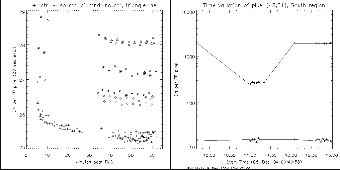
 |
Documentation > SXT Observation Notes > this page |
Image name: Orbit_Dark_Changes.png (click image to enlarge)
Image size: 10.8060 KB (1024x512)
Date submitted: 09-Dec-1994

VARIATIONS OF DARK SIGNAL
This figure illustrates the variation in dark signal in 4 different
64x64 pfi centered at
Location ROIT N-S E-W
ctr 4 128 128
sth 5 64 128
nth 6 196 128
ne 7 196 196
where the N-S and E-W addresses are taken from the ART section of the
ROI table, they are in QR pixels. All the data were taken with the
standard 2 minute UV flood interval over the period
ctr (first, last) = ' 1-DEC-94 14:43:38', ' 8-DEC-94 13:00:14'
sth (first, last) = ' 8-DEC-94 09:40:58', ' 8-DEC-94 13:00:46'
nth (first, last) = ' 8-DEC-94 09:41:30', ' 8-DEC-94 12:58:46'
ne (first, last) = ' 8-DEC-94 09:42:06', ' 8-DEC-94 12:59:18'
Note that all of the curves follow rughly the same shape but have
surprising differences in amplitude. The sth (south) data actually
follow 2 different curves. The reason for this is revealed in the RH
plot which shows that a bright dark spike switched to low and then back
to high during the observing period. The lower curve from pixel (49,61)
illustrates the amplitude and variation of a "normal" pixel. The
differences in amplitudes of the different pfi locations of the LH figure
really reflects the variations in major dark spike populations of those
particular pfi's.
I have verified these relative amplitudes with a recent DARKCAL frame.
From these data I conclude that the slow orbit variation of dark signal
can be represented by a single algorithm applied to every pixel in a
dark frame. The same is probably true for the early sharp decrease
but this remains to be verified by experiment -- which I will go and
set up now.
L. Acton 12/9/94